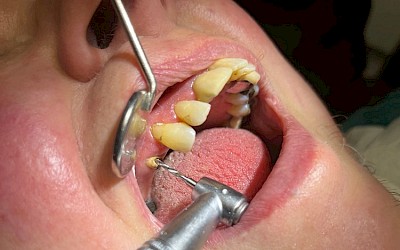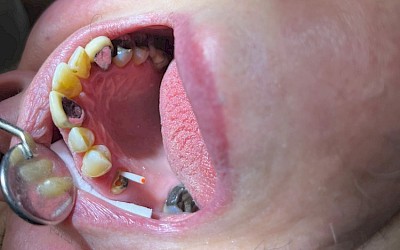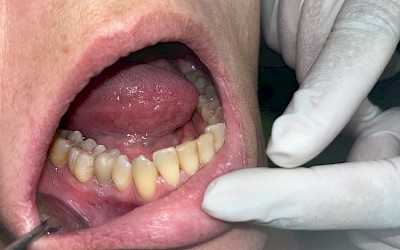It is also universal to be able to cover many indications with one material
Dental restorations require many perfectly coordinated work steps with excellent materials. Universal adhesive systems can be used to make the workflow clear and efficient. Together with TOKUYAMA DENTAL, the specialist journal DENTAL BAROMETER was looking for four offices that are clinically testing the truly universal adhesive system UNIVERSAL BOND II and presenting their experiences in the form of case reports. In the following article you can read how dentist Gerhard Dalheimer from Schwalbach/Elm (Germany) used the materials in different situations to the satisfaction of his patients.
Dentist Gerhard Dalheimer has been in private practice in Schwalbach/Elm for 28 years. Over time, he has specialised in the areas of Cerec and CMD + prosthetics and treats his patients together with his colleague Dr Hasan Ackay. Efficiency is a very important factor in everyday dental practice and, against the background of constantly rising costs, materials such as UNIVERSAL BOND II and ESTECEM II PLUS from TOKUYAMA DENTAL are good alternatives to previous materials because they enable a universal and correspondingly time-saving method of working. The following four patient cases show how dentist Gerhard Dalheimer used these materials in clinical trials to the complete satisfaction of the practitioner and the patients.
Case 1: Bonding a veneer to tooth 13
The 70-year-old patient presented because the veneer on 13 had come loose (Fig. 1a). After inspection of the tooth and the veneer, the reattachment could be started. The veneer and the tooth were cleaned of the old cement and then it was tried on again.
The veneer and the tooth were then cleaned with alcohol and dried, the UNIVERSAL BOND II (A/B) was mixed and applied to the veneer and the tooth and blown (Figs. 1b and 1c). The ESTECEM II PLUS Universal Paste was applied to the veneer and placed on the tooth (Fig. 1d).
The excess was removed after 3 sec. of light curing and then cured again from the vestibular and palatal sides for 1 min. each (Fig. 1e). The result is very satisfactory after a very short treatment (Fig. 1f).
Case 2: Cementation of a post in preparation for a bridge abutment on tooth 14
The 56-year-old patient has been under our care for a long time. She is healthy and her medical history is unremarkable. Tooth 14 has been endodontically restored for a long time and had no prosthetic restoration. The patient presented for a new restoration after a fracture of the old build-up filling (Fig. 2a). We took a radiograph (Fig. 2b) and discussed the treatment options of a core build-up and a bridge restoration. The two root canals were prepared with the TOKUDRILL up to the first mark (Fig. 2c) and then the length was checked with the Verifier. Subsequently, the quartz fibre posts were inserted on a trial basis (Fig. 2d and 2e). The UNIVERSAL BOND II (A/B) was mixed and applied to the pins as well as into the canals and blown (Fig. 2f). The ESTECEM II PLUS Universal Paste was applied to the canals (Fig. 2g) and the posts were inserted into the canals (Fig. 2h).
The excess was removed and then light-cured. Finally, the die was built up with a dual-curing composite and the tooth and prepared (Fig. 2i to 2l). The bridge restoration will be done shortly.
Case 3: Crown cementation
This patient is 45 years old. Tooth 45 had already been treated endodontically some time ago. In the course of this clinical trial, it has now been restored with a crown in one-single- visit chairside. The crown is made of a zirconium oxide-reinforced lithium silicate ceramic (centra dou). After the tooth was prepared (Fig. 3a), the crown was fitted. First, the crown and the stump were cleaned with alcohol and dried, the UNIVERSAL BOND II (A/B) was mixed and applied to the crown as well as the stump and blown (figs. 3b and 3c). The ESTECEM II PLUS Universal Paste was applied to the crown and used on the die (Fig. 3d).
The excess (Fig. 3e) was removed after a 3 sec. light cure. The crown was then cured again from all sides for 30 seconds each. The result after such a short treatment period is very satisfactory for the patient (Fig. 3f).
Case 4: Repair of veneer 13, 12
The patient is 65 years old and presented to our practice because the veneer on the crowns regio 12,13 had chipped off (Fig. 4a). First, UNIVERSAL BOND II (A/B) was mixed (Figs. 4b and 4c), applied to the crowns and air-blown.
Then ESTELITE COLOR Medium Chroma Opaque was applied to the non-precious metal framework, followed by restoration of the veneer with ESTELITE ASTERIA A2B and finally polishing.
Even such indications, which are very unattractive for our patients from an aesthetic point of view, can be easily solved in a very short time and to the complete satisfaction of the practitioner and patient (Fig. 4d) with the universal adhesive system UNIVERSAL BOND II from TOKUYAMA and the other, optimally matched product range from TOKUYAMA DENTAL.

Author:
Gerhard Dalheimer
Dentist
Dental Office Gerhard Dalheimer & Dr. Hasan Akcay
Sebastianstr. 8
66773 Schwalbach/Elm
Germany




























